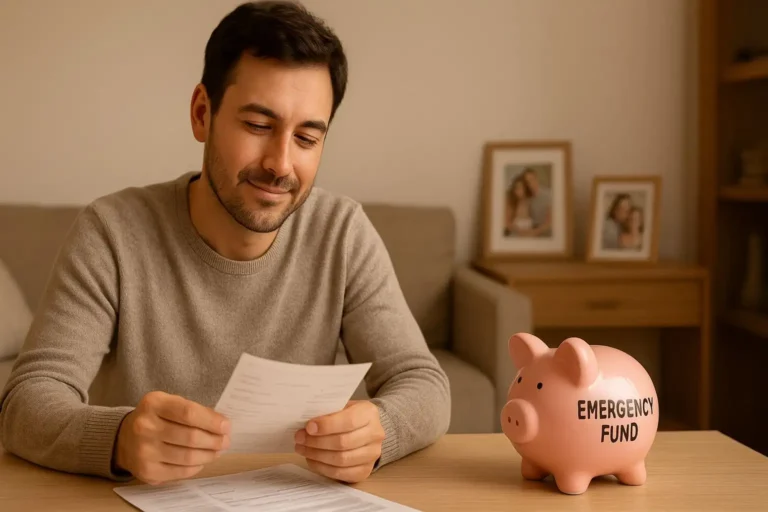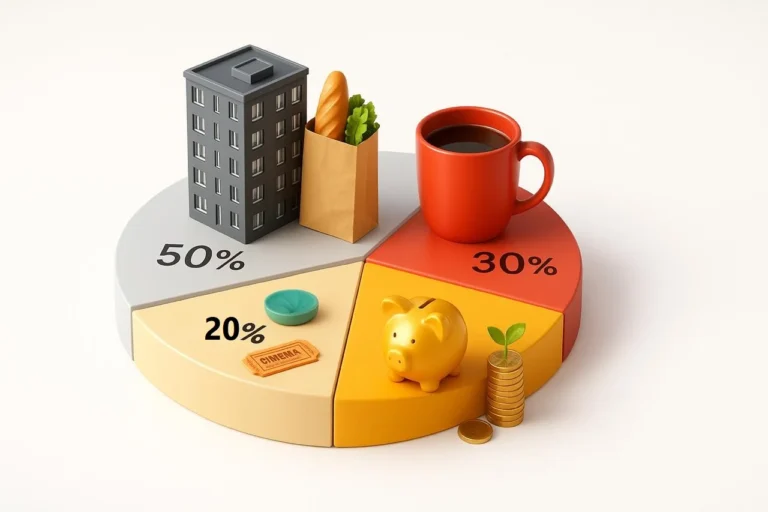A Fresh Take on Emergency Funds
Ever wondered what holds your emergency fund back from truly working for you? If your cash is parked in a low-interest account, consider the power of a high-yield savings account for emergency fund — a smart, stress-free way to grow your safety net. By putting emergency fund into HYSA, you not only keep your money liquid but also unlock the benefits of high-yield savings account, earning more while you sleep.
Picture this: you need to access cash quickly, so you are withdrawing money from HYSA, not draining your returns. That’s the beauty of a high-yield savings account for emergency fund — fast access, great interest, and peace of mind. We’ll walk through how to build an emergency fund the smart way, answer “Should I keep my emergency fund in a HYSA?”, and explore the top emergency fund savings account strategies that financially savvy people rely on.
By the end, you will understand how to build an emergency fund with purpose, know where to keep your emergency fund for both growth and safety, and be ready to treat your cash like the asset it is. Ready to supercharge your emergency fund savings account? Let’s dive in.
What Is a High-Yield Savings Account (HYSA)?
A high-yield savings account is essentially the same as a regular savings account—but with one major upgrade: a significantly higher interest rate. Instead of earning a nominal 0.01% like many traditional banks, HYSAs can offer rates anywhere from 4% to 5% or even higher. That means your emergency fund not only sits safely but grows exponentially faster over time.
Key Advantages of HYSAs:
• Higher Interest Rates: Imagine turning $10,000 into roughly $400 in interest after one year (at a 4% APY) compared to just a few dollars with a traditional account.
• Liquidity: You still have easy access to your money when you need it—no lengthy lock-in periods or hefty withdrawal penalties.
• Safety: Most high-yield savings accounts are FDIC-insured (or NCUA-insured for credit unions), meaning your deposits are protected up to $250,000 per depositor.
• Low Fees: Many HYSAs come with no monthly maintenance fees or minimum balance requirements, ensuring your money grows without being chipped away by charges.

Why Your Emergency Fund Needs a High-Yield Boost
When life throws you unexpected expenses, you want your emergency fund to be as robust as possible. But if your money is not working hard, you could be losing out on potential gains. Let’s look at a quick comparison:
• Traditional Savings Account: $10,000 at 0.01% APY earns about $1 a year.
• High-Yield Savings Account: $10,000 at 4% APY earns around $400 a year.
That is a difference of $399! In practical terms, every dollar you keep in a traditional account could be earning 400 times more in a HYSA. The math is clear: to counter inflation and build long-term financial resilience, your emergency fund should be parked where it can grow.
A Relatable Scenario;
Think of your emergency fund as a garden. A traditional savings account is like planting seeds in rocky soil—they might sprout, but growth is minimal. A high-yield savings account for emergency fund, on the other hand, is like planting in rich, fertile soil. Your money flourishes, giving you a bountiful harvest when you need it most.
How to Choose the Best High-Yield Savings Account for Emergency Fund
Not all high-yield savings accounts are created equal. When picking the right HYSA, consider the following factors:
1. Interest Rate (APY): Look for rates that are competitive and consistently high. Even a small difference in APY can add up significantly over time.
2. Fees and Minimums: Choose accounts with no monthly fees and minimal or no minimum balance requirements to avoid unnecessary costs.
3. Accessibility: Ensure the bank offers easy online and mobile access, so you can transfer money quickly in an emergency.
4. FDIC/NCUA Insurance: Verify that your chosen account is federally insured to protect your deposits.
5. User Experience: A clean, intuitive online or mobile app makes managing your money hassle-free, especially when you need to make quick transfers.
Actionable Checklist:
• Compare Rates: Use comparison websites like NerdWallet, Bankrate, or MoneySupermarket.
• Read the Fine Print: Understand any withdrawal limitations or promotional “teaser” rates that may drop after a short period.
• Test the App: Download the bank’s mobile app and explore its features—this will be your lifeline during an emergency.
• Verify Insurance: Confirm that the account is FDIC or NCUA insured for peace of mind.
Easy Steps to Transition Your Emergency Fund to a HYSA
Switching your emergency fund from a traditional savings account to a high-yield option might seem daunting, but it is surprisingly straightforward. Here is a simple, step-by-step guide to help you make the move:
1. Research and Compare:
• Use reputable financial websites to shortlist a few high-yield savings accounts.
• Compare APYs, fees, and user reviews.
2. Open a New Account:
• Visit the chosen bank’s website and fill out the online application.
• Gather necessary documents (driving license, Social Security number, and any other required identification).
3. Link Your Existing Bank Account:
• Connect your current bank account for seamless transfers.
• Ensure the transfer process is simple and quick (most banks offer ACH transfers).
4. Transfer Your Emergency Fund:
• Decide on an initial amount to transfer.
• Consider doing a test transfer to familiarize yourself with the process.
• Schedule the full transfer once you are comfortable.
5. Set Up Automatic Transfers:
• Arrange for recurring deposits from your paycheck or checking account to steadily grow your emergency fund.
• Even small, regular contributions can make a big difference over time.
6. Monitor Your Growth:
• Use the bank’s mobile app to track your account balance and earned interest.
• Adjust your automatic transfers if needed to meet your savings goals.
Real-Life Example
Take Sarah, a 32-year-old freelance graphic designer. She had $15,000 in her traditional savings account earning almost nothing. After researching, Sarah decided to open an high-yield savings account for emergency fund at an online bank offering 4.5% APY with no fees. She transferred her emergency fund over and set up a weekly automatic transfer of $50 from her income. Within a year, not only did her emergency fund grow to over $16,000 due to regular contributions, but she also earned an extra $675 in interest—money that could help cover unexpected expenses.
Is Your Emergency Fund Working for You?

Take a few moments to answer these reflective questions. They’ll help you evaluate whether your current emergency fund setup is truly serving you:
1. Accessibility Check:
• Can you access your emergency funds quickly if an unexpected expense arises?
• Is your money locked in a low-interest account that discourages you from using it?
2. Growth Potential:
• Is your emergency fund earning a competitive interest rate, or is it barely growing?
• Have you compared your current savings account’s APY with that of high-yield savings accounts?
3. Financial Peace of Mind:
• Do you feel confident that your emergency fund will cover at least three to six months of expenses?
• Would you feel more secure if your money were growing more effectively?
If you answered “no” to any of these questions, it might be time to consider switching to a high-yield savings account. Write down your answers and set a goal to improve in at least one area this month.
💡 Building a Habit of Savings: Tips & Tricks for Using a High-Yield Savings Account for Emergency Fund
If you’re already on board with the idea of parking your emergency savings in a high-yield savings account for emergency fund purposes, here are some pro-level strategies to maximize your returns without compromising safety or accessibility.
1. Choose a HYSA With Zero Fees and Unlimited Transfers
Not all HYSAs are created equal. Some might eat away your interest gains with maintenance fees or limit monthly withdrawals. Look for an online savings account for emergency funds that offers:
• No monthly fees or minimum balance requirements
• FDIC/NCUA insurance up to $250,000
• Unlimited (or generous) number of transfers/withdrawals
• Mobile app + desktop interface for quick access
💡 Pro Tip: Always read the fine print—some banks call it a “savings account” but treat it like a CD with limitations.
2. Set Up Automatic Transfers to Stay Consistent
Don’t rely on memory or motivation—automate! Automating even small transfers helps you consistently build your emergency fund savings account without feeling the pinch.
Here is how to build an emergency fund automatically:
• Schedule weekly or bi-weekly transfers from checking to HYSA
• Increase the amount with every salary hike
• Use “round-up” savings apps that push spare change into your HYSA
💡 Why it matters: Automation = discipline without effort. It’s how the financially free stay that way.
3. Label and Separate: Don’t Mix It with Other Goals
It’s tempting to use your emergency fund to buy a new phone or plan a getaway. Don’t. Give your HYSA for emergency fund a nickname like “Break Glass Only” to remind yourself of its true purpose.
You can even:
• Open a separate HYSA just for emergencies
• Label your accounts: “Emergency 🚨,” “Home Repairs 🛠,” “Vacay ✈”
• Use a different bank to reduce temptation
💡 Think of your HYSA as a fire extinguisher—you hope you never use it, but you sure want it ready when needed.
4. Track Rates Regularly and Switch If Needed
The benefits of high-yield savings accounts include compounding interest—but rates fluctuate. Keep tabs on rate changes and switch if your current HYSA dips significantly.
Check rates every 6–12 months on comparison platforms. If another account offers better APY, transferring is typically hassle-free and worthwhile for larger funds.
💡 Just a 1% difference on ₹1,00,000 could earn you ₹1,000 more in a year—free money for staying informed!
5. Strategic Withdrawals: Know What’s Emergencies vs. Inconveniences
Withdrawing money from HYSA should feel like breaking emergency glass—so be clear on what qualifies as an actual emergency.
Emergency examples:
• Job loss or income disruption
• Medical emergencies
• Major home or car repairs
• Unforeseen family emergencies
Avoid using it for:
• Last-minute holidays
• Fancy gadgets
• Sales or discounts
💡 Every rupee you don’t spend frivolously today adds strength to your emergency savings strategy tomorrow.

FAQs: (Frequently Asked Questions)
- Should I keep my emergency fund in a HYSA?
Absolutely. A high-yield savings account for emergency fund offers a higher return than standard accounts while keeping your money liquid. The benefits of high-yield savings account—like competitive interest, FDIC/NCUA insurance, and no early withdrawal penalties—make it ideal for emergencies. When you keep your cash in a HYSA, you’re balancing safety with growth, following a strong emergency savings strategy.
- Are HYSAs “good enough” for emergency funds?
Yes, they’re more than good—they’re often the best option. HYSAs pay significantly more interest than traditional checking or savings accounts. With yields typically around 4–5%, your emergency fund remains accessible while growing steadily. Compared to investing risky assets (which might be down when you need them), a HYSA for emergency fund is reliable and strategically sound.
- Should I put all my money in a HYSA?
Not necessarily. Your emergency fund savings account in a HYSA should cover 3–6 months of living expenses. Beyond that, excess money might go to other goals—like retirement, paying off debt, or investing. Yes, you benefit from high-interest savings for emergencies, but remember to allocate funds according to your broader financial plan.
- How much money should I leave in HYSA?
Experts suggest keeping at least 3–6 months of essential living costs in your HYSA. Estimate your monthly expenses—rent, food, utilities, insurance—and multiply by 3–6. That’s your target. If your emergency fund savings account exceeds that, consider redirecting surplus to long-term goals like investments or retirement accounts.
- Where do you keep your emergency fund?
The short answer: in a top-tier online savings account for emergency funds or high-yield savings account for emergency fund. Online banks often offer better APYs than brick-and-mortar institutions because they have lower overhead. Just ensure the bank is FDIC- or NCUA-insured and that you’ll have fast access to your funds when withdrawing money from HYSA.
- I have saved up a good sum of cash in a HYSA, now what?
Congrats! Now it’s time to reassess:
• Are you still within the recommended 3–6 months range?
• Do you need to adjust your emergency savings strategy?
• Review your HYSA’s interest rate—if it dropped, look for a new emergency fund savings account with better APY.
• If you’ve exceeded the emergency fund threshold, consider moving excess into investments like index funds or retirement accounts to pursue long-term growth.
- Seeking advice on the best HYSA for my emergency fund—what should I look for?
Here is your quick checklist:
• High APY (4% or more)
• No monthly fees or minimum balance
• FDIC/NCUA insurance
• Easy transfers and withdrawals
• Transparent terms—no teaser rates that expire
• Strong mobile app or website experience
These factors define a strong high-yield savings account for emergency fund—combining interest, accessibility, and simplicity.
- How to build an emergency fund with a HYSA?
1. Choose a reputable online savings account for emergency funds with a strong APY.
2. Set up automatic transfers from your checking account—weekly or monthly.
3. Track progress; celebrate milestones (e.g., first $1,000 in emergency fund savings account).
4. Once funded, keep topping it up when needed, especially after using it for emergencies.
Smooth, automatic growth helps you systematically build and maintain your fund.
- What happens when I need to withdraw from HYSA during an emergency?
A big concern—but an easy one. Withdrawing money from HYSA usually takes 1–3 business days via ACH. Some banks offer instant transfers with a small fee. The key is ensuring your chosen emergency fund savings account processes withdrawals quickly and without penalties. Monitor your liquidity needs so you’re never caught off guard.
- How often should I review my HYSA rate?
Check your HYSA APY every 3–6 months. Rates can drop unexpectedly. Using a high-yield savings account for emergency fund means staying nimble—if your rate dips significantly, consider switching to a better online savings account for emergency funds. Annual rate reviews ensure your fund is always working optimally.
Final Thought: Secure Today, Sleep Peacefully Tomorrow
Building your high-yield savings account for emergency fund is not just smart—it is essential. In a world full of uncertainties, having your “financial oxygen mask” ready gives you peace of mind and real-life resilience. From putting emergency fund into HYSA to tracking interest and avoiding misuse, each strategy you apply strengthens your money safety net.
Ready to take full control of your financial safety?
💌 Subscribe to TheFitFinance newsletter for weekly money hacks, proven savings tips, and exclusive tools to make your finances unstoppable!
🔁 Want to Master Saving Habits First?
Before you start stashing that emergency fund, make sure your money-saving mindset is rock solid. Read our post: “How to Save Money Fast for Kids—And Learn While You Teach” to build lasting financial discipline—for you and the next generation. 👨👩👧👦💰







